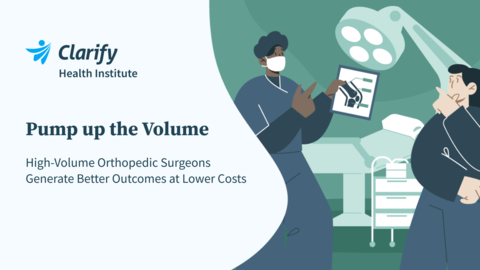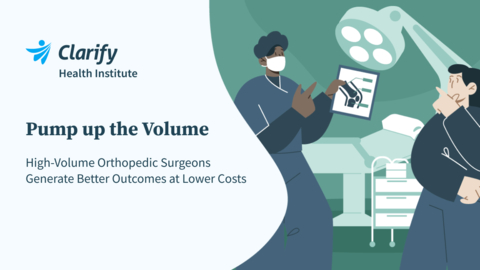SAN FRANCISCO--(BUSINESS WIRE)--Clarify Health Institute (CHI), the research arm of Clarify Health, has published new research highlighting the relationship between the number of orthopedic surgeries a doctor has performed and patient outcomes.
More than 15 million Americans undergo elective surgery each year, at an estimated cost of $147.2 billion. Most patients are unaware of the cost and quality of care until after the procedure. Surgical volume, the frequency with which surgeons perform complex procedures, is widely recognized as a key determinant of healthcare quality. Yet, despite this and numerous policy reforms enacted to empower consumers to make more informed care decisions, there is little publicly available information about provider surgical volumes for patients, their families, and payers.
“Hip and knee replacements are the most common elective orthopedic surgeries where it is possible for patients to choose their provider,” said CHI’s Chief Analytics and Privacy Officer Niall Brennan. “Thousands of adverse clinical events could be avoided each year by making surgical volume information easily accessible and steering patients to high-volume providers.”
Clarify Health Institute is focused on delivering data-driven insights into the quality and efficiency of U.S. healthcare. The Institute initiated this research, Pump Up the Volume: High-Volume Orthopedic Surgeons Generate Better Outcomes at Lower Costs, to expand the assessment of surgical volumes on healthcare outcomes beyond existing studies that have leveraged relatively small-scale samples for specific surgical procedures. The research leveraged a large, observational sample of national health insurance claims from 2017 to 2020 to review provider volume, fewer than 10 surgeries are low, more than 100 surgeries are high, and assessed patients that recently underwent total hip arthroplasties (THA), commonly known as hip replacements, and total knee arthroplasties (TKA), or knee replacements, in 2021. Examining over 178,000 orthopedic procedures from more than 23,500 providers, Clarify’s sample accounts for approximately 14% of all hip and knee replacements completed annually in the U.S.
“There is a clear linear relationship—the more operations a surgeon performs the better the patient does,” said Ezekiel Emanuel, MD, vice provost for global initiatives, University of Pennsylvania, co-director of Healthcare Transformation Institute, and a strategic advisor to Clarify Health. “If we shift more patients to get their hip and knee replacements by high-volume surgeons, it will be a huge win-win. Patients will win with fewer complications, fewer revisions, and fewer hospital readmissions. And the system will win by having lower costs. Now the challenge is to shift patients to see more experienced surgeons.”
Some of the primary findings of this brief include:
Wide variation exists in surgical volume (2017-2020) for hip and knee replacements performed in 2021
- Approximately 50% of hip and knee replacement episodes were performed by providers who had performed less than 50 surgeries from 2017-2020 within the sampled commercial claims
- 17% of hip replacements and 13% of knee replacements in 2021 were performed by surgeons with less than 10 prior surgeries within the sampled commercial claims
Higher surgical volume of hip and knee replacements resulted in better outcomes across multiple dimensions and care settings, even when controlling for patient case mix and provider characteristics.
- Lower rates of post-acute inpatient readmission at both seven and 60 days, with rates for high-volume surgeons between 37%-51% less than low-volume surgeons
- Combined rates of post-surgical emergency department (ED) visits, inpatient readmissions, and revisions surgeries were approximately 14% lower for hip replacements and 19% lower for knee replacements
- Total hip and knee replacement episode costs are approximately $2,800 and $1,500 lower, respectively, when performed by a high-volume versus a low-volume surgeon
Volume-Outcome Relationships Largely Remain When Stratified by Place of Service
- Combined rates of negative outcomes for patients treated in outpatient (OP) and ambulatory surgical center (ASC) settings are 13%-24% and 27%-45% lower on average, respectively, compared to hip and knee replacements performed in inpatient (IP) settings.
“At Clarify, transparency is at the heart of everything that we do. Healthcare is highly personal, and at the most fundamental level, patients deserve to have agency over the decisions and actions affecting their health,” said Jean Drouin, MD, CEO and founder, Clarify Health. “This research underscores health care leaders’ responsibility to make comprehensive surgical volume data widely available to patients, their families, and other industry stakeholders to lower costs and improve health outcomes."
To access the full report, visit https://clarifyhealth.com/brief-pump-up-the-volume-high-volume-orthopedic-surgeons-generate-better-outcomes-at-lower-costs/
About Clarify Health
Clarify Health is an enterprise analytics and value-based payments platform company that empowers payers, providers, and life sciences companies to deliver better care, therapies, and outcomes with actionable patient journey insights. Clarify’s cloud-based business applications are built on the Clarify Atlas Platform, which maps 300M+ patient journeys to deliver 18B+ AI-powered predictions and surface insights with speed and precision. Clarify’s products illuminate actionable opportunities to drive growth, optimize networks, improve care delivery, manage population health, maximize value-based care performance, and bring therapies to market. With Clarify, healthcare organizations can leapfrog from point-solution and manual analytics to self-service, rapid generation of enterprise insights that light the path to better care and outcomes.
About the Clarify Health Institute
Clarify Health Institute is the research arm of Clarify Health, an enterprise analytics and value-based payments platform company. It leverages Clarify’s data assets, including claims, clinical, and social determinants of health data across 300 million patient journeys to shine a light on important healthcare issues and explore trends. It provides industry leaders, policymakers, academic researchers, the media, and the public unprecedented access to data-driven healthcare insights.




